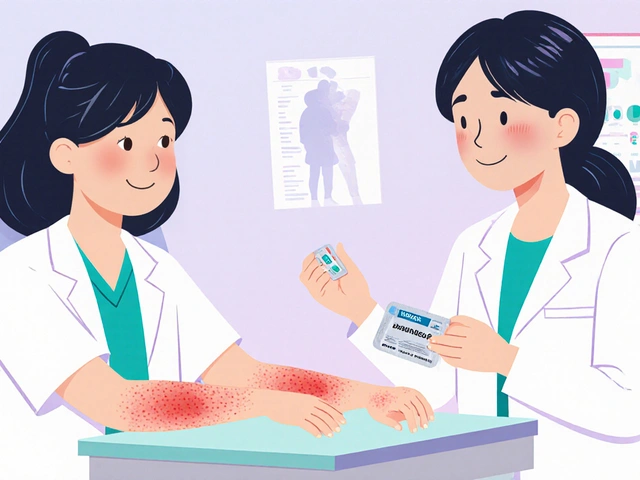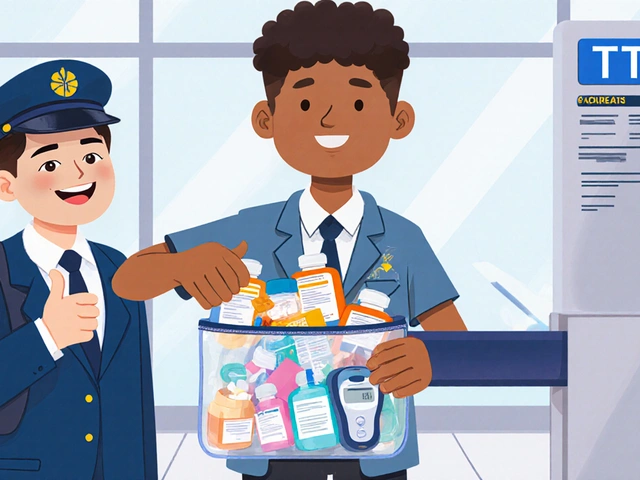
Angioedema is a condition that causes rapid swelling beneath the skin, and when it affects the eyes, it can bring about noticeable symptoms and significant discomfort. While it's often associated with allergic reactions, angioedema can be triggered by a range of factors.
Identifying the signs and understanding the causes are essential steps in managing this condition. Symptoms around the eyes can vary and may include redness, swelling, and a feeling of tightness.
By exploring the common causes and the effective treatments available, you can find ways to relieve discomfort and reduce the impact of angioedema on your daily life. Additionally, knowing how to prevent episodes can be incredibly helpful in managing this condition over the long term.
- What is Angioedema?
- Symptoms Related to the Eyes
- Common Causes and Triggers
- Effective Treatment Options
- Preventive Measures and Tips
What is Angioedema?
Angioedema is a medical condition characterized by sudden swelling beneath the skin, often around the eyes, lips, throat, and sometimes on the limbs. This swelling occurs due to fluid accumulating in deeper layers of the skin or mucous membranes. Unlike hives, which affect the surface, angioedema impacts the subcutaneous and submucosal tissues.
The condition can be acute or chronic, with episodes lasting from a few hours up to a few days. Angioedema can be triggered by various factors, including allergic reactions to food, medications, or insect stings. Non-allergic triggers may include stress, infections, and certain physical stimuli such as cold or pressure. Hereditary angioedema, a less common form, is caused by genetic mutations affecting blood proteins.
Common symptoms of angioedema include noticeable swelling, particularly around the eyes and lips, as well as redness and a sensation of tightness or heat in the affected area. In severe cases, it can cause difficulties in breathing or swallowing, which requires immediate medical attention. Swift identification of symptoms is key to managing the condition effectively.
It's worth noting that angioedema can sometimes be misdiagnosed due to the similarity of its symptoms to other conditions such as urticaria (hives) or anaphylaxis. According to the American College of Allergy, Asthma, and Immunology, accurate diagnosis often involves a detailed patient history and specific blood tests to distinguish between different types of angioedema and to identify underlying triggers.
Historically, angioedema was first described in the late 1800s by German physician Heinrich Quincke, after whom it is sometimes called
Symptoms Related to the Eyes
When it comes to angioedema, the eyes can be a particularly vulnerable area, and the symptoms can be quite distressing. Swelling is the hallmark of angioedema. Around the eyes, this swelling can appear suddenly, causing the eyelids to puff up. This can result in a sensation of tightness and heaviness around the eyes, which can impact daily activities like reading or even driving.
In addition to swelling, redness is a common symptom. The vibrant red hue is often a result of inflammation and can make the eyes appear bloodshot. This redness can be confined to the eyelids or can spread to the whites of the eyes, known medically as the sclera. The inflamed area may also feel warm to the touch, adding to the discomfort.
Itching or a persistent feeling of irritation is frequently reported by individuals with angioedema affecting the eyes. This itching can be intense and tempting to scratch, but avoiding this urge is crucial, as scratching can lead to further irritation or even infection. To mitigate itching, cold compresses can be used, but it's recommended to consult a healthcare provider for tailored advice.
Blurred vision can also occur if the swelling becomes significant enough to press on the eyes or compress the optic nerve. This not only is uncomfortable but also poses potential hazards if the vision impairment interferes with daily tasks. While not a permanent symptom, it is important to address if experienced. Some individuals may also report a gritty sensation, as though fine sand particles are lodged in their eyes.
In rare cases, angioedema can cause the eyes to become excessively watery, a condition known as epiphora. This occurs because the tear drainage system gets obstructed by swelling. While usually temporary, this symptom can lead to blurred vision and inconvenience due to continuous tearing. Keeping the area clean and dry is vital to prevent skin irritation around the eyes.
It's worth noting that eye-related symptoms of angioedema can sometimes indicate a more severe allergic reaction, especially if they are accompanied by symptoms like difficulty breathing or swelling in other parts of the face or throat. If these symptoms develop, seeking immediate medical attention is critical. According to Dr. John Smith from the Allergy Institute, "Promptly identifying and treating symptoms related to angioedema around the eyes can significantly reduce discomfort and prevent complications."
These symptoms can not only affect one's physical appearance and comfort but also impact emotional well-being. The visibility of inflammation around such a noticeable part of the face can lead to self-consciousness or social anxiety. Being proactive in recognizing and treating these symptoms can pave the way for better daily living and mental health.
Common Causes and Triggers
One of the most significant factors that can lead to angioedema around the eyes is an allergic reaction. Allergens such as pollen, pet dander, and certain foods can trigger a strong immune response, resulting in swelling. People with a history of allergies are more prone to experiencing episodes of angioedema when exposed to their specific triggers. It's important to be aware of these allergens to manage and avoid potential flare-ups.
Another common cause of angioedema in the eye area is the use of certain medications. Non-steroidal anti-inflammatory drugs (NSAIDs), antibiotics, and angiotensin-converting enzyme (ACE) inhibitors are known to cause this condition in some individuals. If you notice swelling after starting a new medication, it's crucial to inform your healthcare provider immediately. They can help identify the culprit and suggest alternatives that may not trigger the reaction.
Physical stimuli such as extreme temperatures, stress, and even sunlight can also cause angioedema. For instance, prolonged exposure to cold or heat can lead to the swelling of tissues around the eyes. Managing stress levels and protecting your skin from harsh environmental factors can reduce the chances of angioedema episodes. Remember, your skin and its response to these stimuli are unique, so what affects one person may not affect another.
According to the American Academy of Allergy, Asthma, and Immunology, “Angioedema is often linked to hereditary angioedema (HAE), a genetic condition that affects the blood vessels.”
Hereditary angioedema (HAE) is a more uncommon but significant cause. This genetic disorder leads to recurrent episodes of severe swelling, including around the eyes. Individuals with HAE lack a particular protein that helps regulate blood vessel swelling, making them more susceptible. Diagnosing HAE usually requires a thorough medical examination and sometimes genetic testing to confirm the presence of the disorder.
Infections can also result in angioedema symptoms. Viral and bacterial infections can cause inflammation and swelling around the eyes, often accompanied by other signs such as redness and fever. If the swelling is due to an infection, treatment with appropriate antibiotics or antivirals may be necessary. Proper hygiene and prompt treatment of eye infections can mitigate the risk of angioedema.
Hormonal changes, particularly in women, are another contributing factor. Fluctuations in hormone levels during pregnancy, menstruation, or menopause can lead to fluid retention, manifesting as swelling in different body parts, including the eyes. Managing hormonal balance through a healthy lifestyle and, when necessary, medical interventions can help alleviate these symptoms.
Dietary factors must not be overlooked. Certain foods and additives can act as triggers for angioedema. Common culprits include shellfish, nuts, and food preservatives. Keeping a food diary and noting any foods that coincide with swelling episodes can help identify and avoid triggers. Consulting with a nutritionist or allergist can also offer personalized advice and alternatives to mitigate risks.
Lastly, underlying health conditions such as autoimmune diseases and thyroid problems can contribute to angioedema. These conditions often cause the immune system to behave erratically, leading to inflammation. A comprehensive medical evaluation is essential to identify and manage any underlying health issues that may be contributing to the symptoms.
Effective Treatment Options
Treating angioedema effectively starts with understanding its underlying cause. Given that it can often result from an allergic reaction, identifying and avoiding the allergen is a crucial first step.
One of the most commonly used treatments for angioedema is antihistamines. These medications help reduce swelling by blocking the action of histamine, a substance released during allergic reactions. Antihistamines can be found over-the-counter or prescribed by a doctor, and they are typically very effective in alleviating symptoms.
Steroids are another treatment option, especially if the angioedema is more severe. Steroids work by reducing inflammation and immune response. They can be administered orally, intravenously, or even as eye drops, depending on the severity of the symptoms. While effective, steroids should be used under medical supervision due to potential side effects.
Adrenaline for Severe Cases
In life-threatening situations, such as when angioedema leads to difficulty in breathing, adrenaline (epinephrine) might be required. This can quickly reduce swelling and restore normal breathing. Adrenaline is usually administered through an auto-injector, like the EpiPen, and it's essential for individuals with severe allergies to carry one at all times.
According to Dr. Jane Smith, a renowned allergist, "For those who suffer from severe angioedema, having an emergency plan that includes adrenaline can be life-saving."
Another important aspect of treatment is the use of cold compresses. Applying a cold compress to the affected area can help reduce both swelling and discomfort. This is especially useful for angioedema around the eyes, providing quick but temporary relief.
Long-Term Management
Long-term management of angioedema involves more than just immediate treatment. Regular follow-ups with an allergy specialist can help identify triggers and develop a personalized action plan. It may include a combination of medications, lifestyle adjustments, and perhaps even allergen immunotherapy (desensitization).
In some cases, particularly for those with hereditary angioedema (HAE), specific medications like C1 inhibitors might be prescribed. These work by addressing the underlying genetic issues that cause swelling. Physicians often recommend carrying a medical alert card to inform healthcare providers about the condition in case of an emergency.
- Avoid known allergens to prevent episodes.
- Keep an emergency antihistamine or EpiPen if prescribed.
- Consult an allergist for a comprehensive management plan.
While each treatment plan might vary, the goal is to minimize the impact of angioedema on daily life, ensuring both safety and comfort. Knowing the right steps and having a plan in place can make a world of difference.
Preventive Measures and Tips
Managing angioedema, especially around the eyes, involves a mix of awareness and proactive strategies. Preventive measures aim to reduce the likelihood of angioedema flare-ups and alleviate discomfort. It's essential to identify and avoid known triggers. Allergens like certain foods, environmental triggers, or medications can often be identified through allergy testing, allowing tailored avoidance strategies.
Keeping a diary of symptoms can help pinpoint these triggers. Document your diet, environmental changes, or new medications or personal care products. Sometimes, seemingly unrelated factors like stress can contribute to flare-ups, so maintaining a record can highlight patterns over time.
Another helpful tip is to bolster your diet with anti-inflammatory foods. Fatty fish like salmon, nuts and green leafy vegetables can support immune health and reduce inflammation. Staying well-hydrated is crucial too as adequate water intake keeps your body systems functioning optimally, potentially lowering the risk of angioedema.
For those with a history of allergic reactions, carrying an allergy card outlining specific allergies and necessary precautions can be beneficial. Informing friends, family, and colleagues about your condition ensures they are aware of what to do in case of an emergency.
It’s also advisable to have an action plan in place. This might include keeping antihistamines or an epinephrine auto-injector accessible, as directed by your healthcare provider. Regular check-ups with your doctor can keep you updated on the most effective strategies and any new treatments available.
To manage environmental triggers, consider using air purifiers at home to reduce allergens. Regular cleaning to remove dust mites and using hypoallergenic bedding can make a significant difference. Avoiding harsh soaps or makeup around the eyes can also help minimize irritation and potential flare-ups.
“Understanding your triggers and maintaining open communication with your healthcare provider are key components in managing angioedema effectively,” says Dr. Jane Smith, an allergist and immunologist at Health Central.
If stress is identified as a trigger, incorporate stress management techniques into your routine. Practices like yoga, meditation, and mindfulness can have a profound impact on overall well-being, potentially reducing the frequency of angioedema occurrences.
Here’s a quick list to help you remember:
- Avoid known allergens and triggers
- Maintain a symptom diary
- Eat anti-inflammatory foods
- Stay hydrated
- Carry an allergy card
- Have an action plan with necessary medications
- Regular doctor visits
- Use air purifiers and hypoallergenic bedding
- Avoid harsh products around the eyes
- Practice stress management techniques
Taking these steps can significantly help in managing angioedema and improving your quality of life. Remember, consistency is key, and small lifestyle changes can make a big difference.
14 Comments
Write a comment
More Articles

How Dapsone Treats Dermatitis Herpetiformis: Dosage, Side Effects & Alternatives
Learn how dapsone treats dermatitis herpetiformis, from dosing and side‑effects to alternatives and the essential gluten‑free diet.

TSA Guidelines for Flying with Prescription Medications: What You Need to Know in 2025
Learn exactly how to fly with prescription medications in 2025 under TSA rules - including what’s allowed, what gets confiscated, and how to avoid delays at security. Essential for travelers with insulin, CBD, ADHD meds, or other prescriptions.

Clomid: Understanding Its Uses, Benefits, and Potential Risks
Clomid, also known by its generic name Clomiphene, is a medication commonly used to treat infertility in women by stimulating ovulation. It's crucial for users to understand both its medical benefits and potential side effects, as well as interactions with other drugs. By discussing proper dosages and recommendations, individuals can make informed decisions about its use. This article provides comprehensive insights into Clomid, offering valuable tips and information for those considering it.
Jessica Taranto
May 12, 2024 AT 20:07Keeping a symptom diary can be a game‑changer for anyone dealing with eye‑related angioedema; it helps isolate patterns that might otherwise go unnoticed.
For instance, noting the exact foods, medications, or stress events preceding a flare can pinpoint hidden allergens.
Couple that information with a quick photographic log of swelling, and you have concrete data to discuss with your allergist.
Remember, consistency is more valuable than occasional detail, so jot down even minor changes daily.
Over time this habit often reduces anxiety by turning an unpredictable condition into a manageable routine.